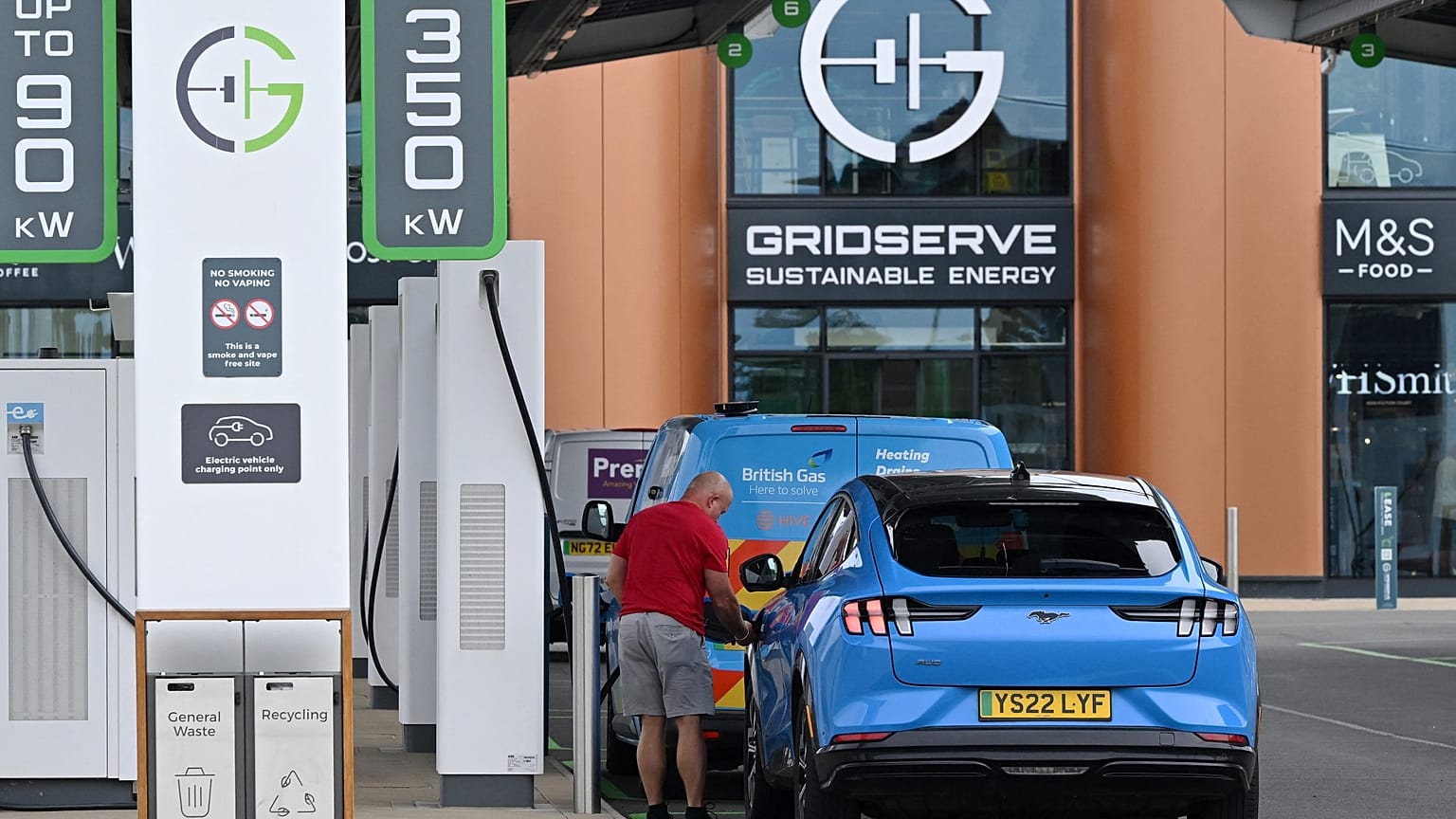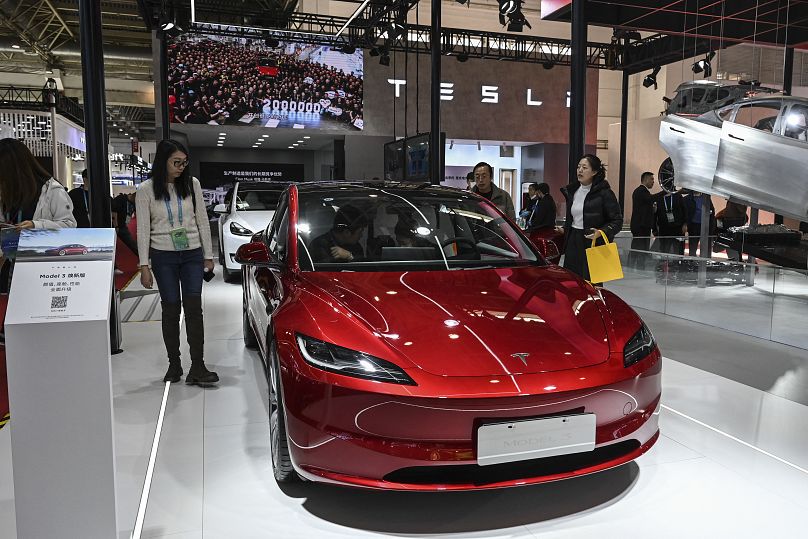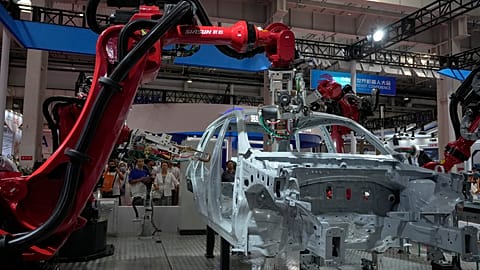The ACEA president has highlighted that the European EV industry may still take until the end of the decade to be at the same levels as global competitors.
The European Automobile Manufacturers’ Association (ACEA) has unveiled its manifesto and roadmap for the European Union’s next five-year mandate in Brussels on 29 November. The manifesto, dubbed “A competitive European auto industry driving the mobility revolution”, focuses on a mobility ecosystem ready for the future.
Euronews Business takes a closer look at what was announced.
Green transition commitment
By releasing it on the eve of the COP28 summit, ACEA also emphasised its commitment to the green transition, as well as the association’s new approach, unveiled in March. The manifesto aims to set concrete actionable plans regarding demand, supply and production.
ACEA President, Luca de Meo, also the CEO of Renault Group, further outlined what needs to be done by the European automobile industry and regulators to bring this roadmap to life, as well as the challenges facing the sector.
He highlighted: “We think that the automotive industry is part of the solution.”
Foremost amongst the challenges is the wave of new policies and regulations anticipated by the election of a new EU Parliament and EU Commission in 2024. A number of regulations have deadlines coming up in or before 2030.
These include the Net Zero Industry Act, the Critical Raw Materials Act, and the CO2 reduction targets and standards for light vehicles, amongst others. With these deadlines coming up, the committee will also have to now speed up its action plan on how to achieve these goals.
New approach to regulations and tariffs
As part of its new manifesto, ACEA recommends that Europe needs to adopt a holistic approach when dealing with automotive challenges, instead of having conflicting regulations. Thus, the EU needs to come up with a cohesive industry policy.
The European automotive industry also needs to be competitive on a global level, especially through affordable and green energy supply. Tech neutrality will also be vital for the mobility revolution.
Clashing regulations by far, seem to be one of the greatest challenges holding the industry back from being as competitive as global peers, despite the European automotive industry willing to spend about €250 billion on the green transition.
As de Meo puts it: “When we have eight new regulations coming each year on average until 2030, it should tell us that there is a bug in the system somewhere.”
This is also true when it comes to tariffs between the UK and the EU following Brexit.
On Wednesday, the European Commission proposed a one-time extension of the existing rules on EU-UK trade tariffs. If accepted, the extension would delay tariffs between the the EU and UK until December 31, 2026.
"Today's decision means that we skip an intermediate phase of somewhat stricter rules of origin that would have applied from 2024 until the end of 2026," said European Commission executive vice-president, Maroš Šefčovič.
"This removes the threat of tariffs on the export of EU electric vehicles to the UK and vice versa on 1 January 2024."
Before this was announced, starting from 1 January 2024, any electric vehicle that was imported or exported between the UK and the EU would have to have proved that it is at least 45% made in either the UK or the EU. Failing to do so would lead to a 10% tariff.
Luca de Meo and several other automakers had been trying to get the tariff postponed for at least three years, with de Meo being very vocal that failure to do so would potentially cost the industry approximately €4.3 billion - so the new will certianly be welcomed on the tariff delay.
The reason for it is because most EV makers in the EU use batteries imported from China and more time is required to quickly upscale battery-making plants and capacities, in order to reduce tariffs and also decrease dependence on the Chinese supply chain.
However, the postponing of the tariff risks reopening the Brexit deal between the EU and the UK, and as such, is seeing quite a bit of backlash, creating further hurdles for the European automotive sector.
More affordable cars
Coming to whether the price of EVs is going to keep increasing due to inflation, as it has done in the last few years, Luca de Meo put on his Renault CEO hat. He highlighted that the company was planning to introduce a smaller, more urban-friendly car, under €20,000 in 2026 and that Renault had been exploring more similar potential designs. However, this would depend highly on the European EV supply chain strengthening as a whole.
He emphasised that the key to the entire sector being part of the solution is to introduce EVs with smaller batteries, which are more suited to actual urban consumption, rather than oversized batteries which do not reflect the true needs of the consumers and are “ecological disasters”.
“So far the regulations in Europe, in the last twenty years have only pushed the weight and the dimensions of the cars up.” de Meo pointed out.
EV competitors such as the US and China already have significant advantages over Europe. In the US, EV manufacturers get significant tax relief for producing vehicles domestically. The Chinese electronic vehicle industry also has a head-start of more than a decade over Europe.
Charging infrastructure improvements
According to de Meo, China has managed to become a source of inspiration for EV makers worldwide by being able to establish the entire EV value chain, from mining to refining, instead of just parts of it. This is something that is likely to take Europe several decades more to achieve.
Not only that, but the Chinese EV has also strongly developed its charging infrastructure, and have strong standards that are adapting all the time and pushing competition. There is also greater cohesion and teamwork between the public and private sectors, as well as across industries.
Furthermore, Chinese EV makers are adopting a realistic approach to the green transition and realising that this change needs to take place at every level of the value chain, not just at isolated stages.
Luca de Meo believes that the EV industry in Europe could possibly catch up to its global peers by the end of the decade as it is not where it should be yet, especially when it comes to expanding the European supply chain. This is especially true when it comes to the charging infrastructure, which needs to grow by about seven to ten times what it is at the moment, to hit 2030 emissions targets.
He also highlighted that since Europe values competition and the free market significantly more, the long-term closing of the European market would not be a viable solution, as this would create inefficiencies and inflate inflation.
ACEA has been trying to reposition itself by being more in touch with consumers and not just the regulators. As part of the reshaping, the committee will strive to be more connected within the automobile industry as well as across borders. It will also engage with think tanks, as well as take public opinion into account and pick only projects with a clear and measurable return of interest.
It estimates a growth of 12% for passenger car registrations in the EU for 2023, to about 10.4 million units. However, this is still about 20% lower than the levels seen pre-pandemic in 2019.
Although 2024 is also expected to see some growth in EU car registrations, it will be much slower than this year, at about 2.5%, taking the number of units up to about 10.7 million units.
The market share for electronic vehicles (EVs) for this year is expected to be around 14% to 14.5%, going up to about 20% next year.



















